Enhancing Organizational Capability: Delegation & Control Methods
VerifiedAdded on 2023/04/25
|18
|4279
|181
Report
AI Summary
This report assesses Balfour Beatty Plc's organizational capability, focusing on translating strategic goals into operational objectives, efficient delegation of responsibilities, and effective control methods. The assessment covers the company's ability to achieve its strategic goals of Lean, Expert, Trusted, and Safe, through various monitoring parameters like net cash flow, employee engagement, customer satisfaction, and lost time injury rate. The report also evaluates the efficiency and effectiveness of current control methods and proposes improvements for delegation and monitoring to enhance organizational performance. Digital tools like Gated lifecycle and project on a page are highlighted as key enablers for achieving efficiency and transparency. The analysis identifies areas for further improvement, such as setting clear targets for operational objectives and implementing action plans for better monitoring and delegation.
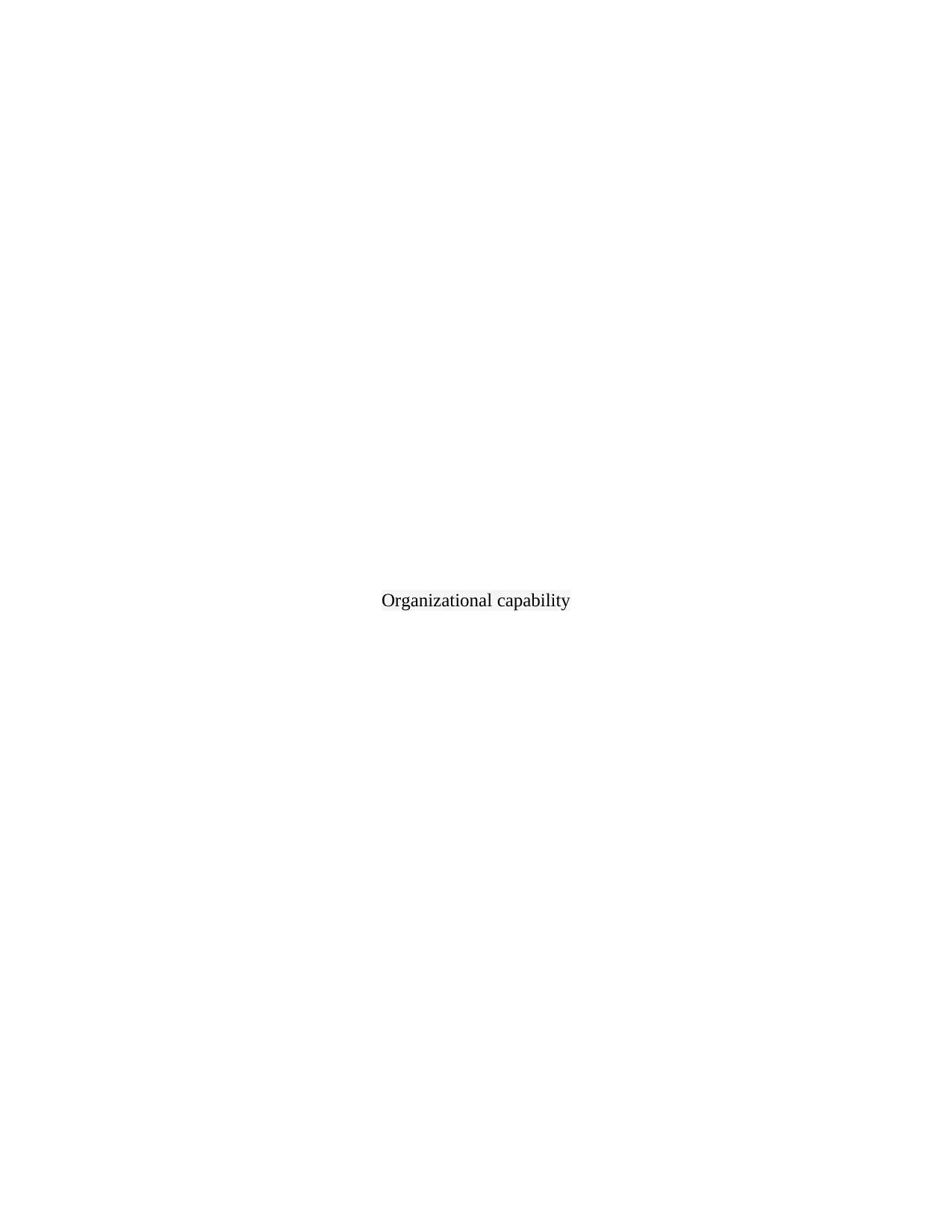
Organizational capability
Paraphrase This Document
Need a fresh take? Get an instant paraphrase of this document with our AI Paraphraser
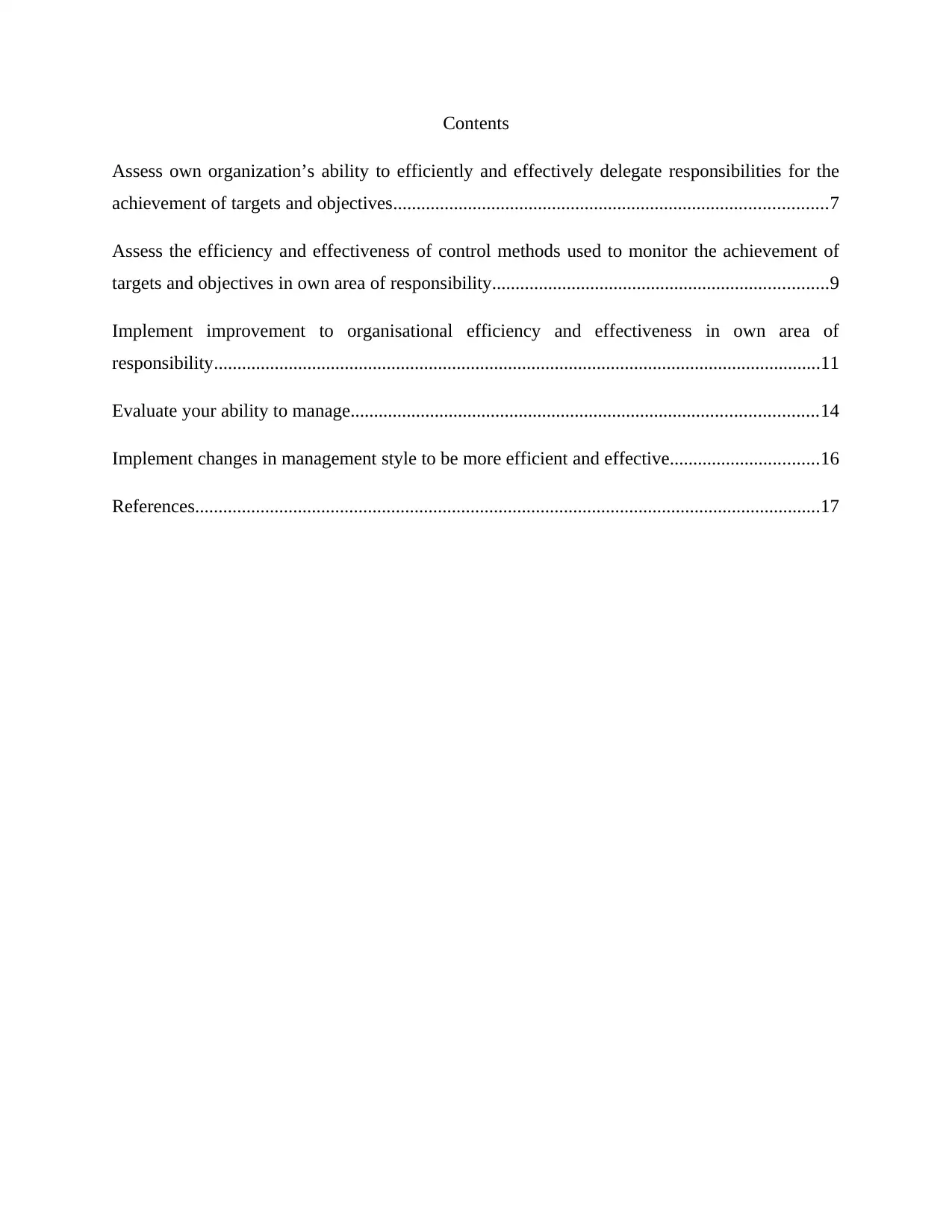
Contents
Assess own organization’s ability to efficiently and effectively delegate responsibilities for the
achievement of targets and objectives.............................................................................................7
Assess the efficiency and effectiveness of control methods used to monitor the achievement of
targets and objectives in own area of responsibility........................................................................9
Implement improvement to organisational efficiency and effectiveness in own area of
responsibility..................................................................................................................................11
Evaluate your ability to manage....................................................................................................14
Implement changes in management style to be more efficient and effective................................16
References......................................................................................................................................17
Assess own organization’s ability to efficiently and effectively delegate responsibilities for the
achievement of targets and objectives.............................................................................................7
Assess the efficiency and effectiveness of control methods used to monitor the achievement of
targets and objectives in own area of responsibility........................................................................9
Implement improvement to organisational efficiency and effectiveness in own area of
responsibility..................................................................................................................................11
Evaluate your ability to manage....................................................................................................14
Implement changes in management style to be more efficient and effective................................16
References......................................................................................................................................17
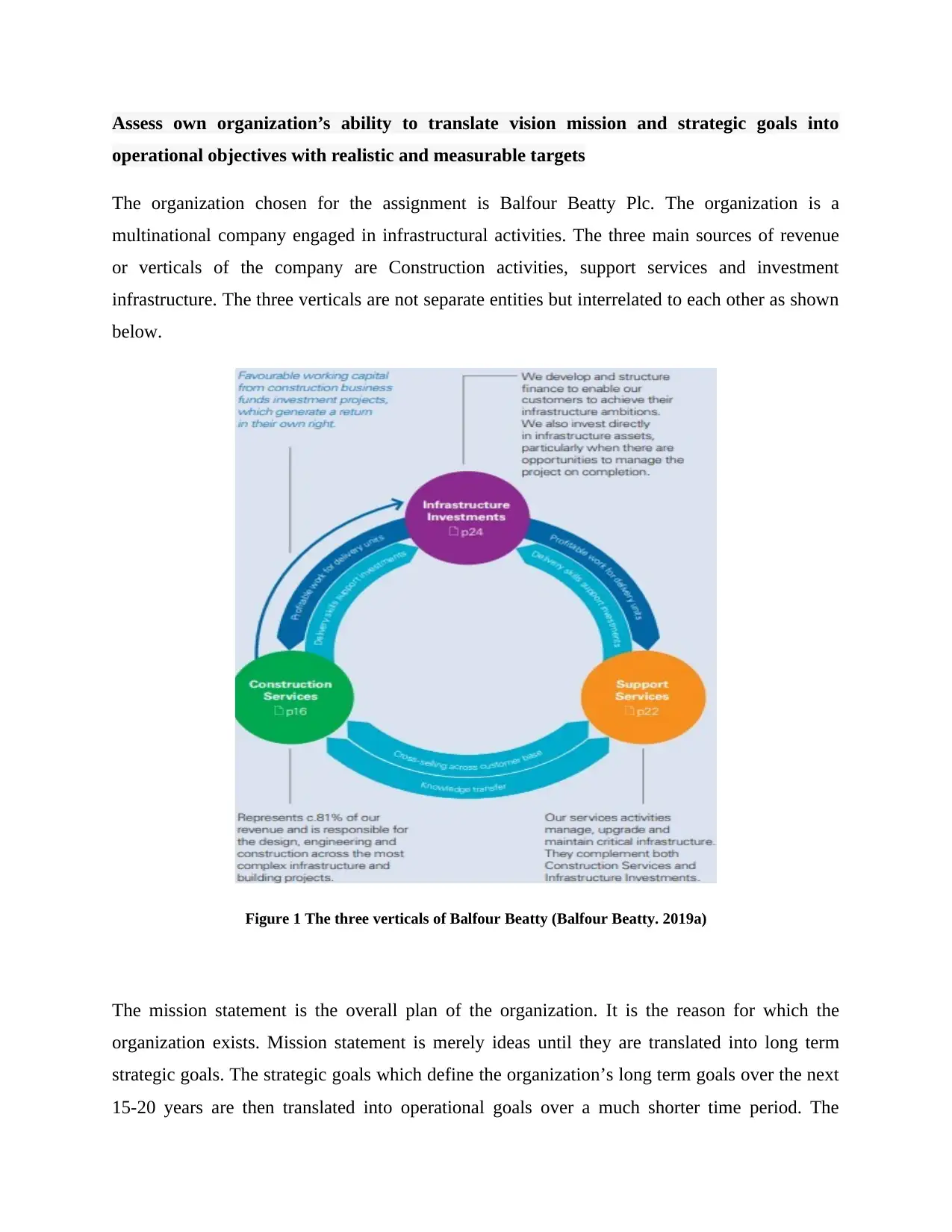
Assess own organization’s ability to translate vision mission and strategic goals into
operational objectives with realistic and measurable targets
The organization chosen for the assignment is Balfour Beatty Plc. The organization is a
multinational company engaged in infrastructural activities. The three main sources of revenue
or verticals of the company are Construction activities, support services and investment
infrastructure. The three verticals are not separate entities but interrelated to each other as shown
below.
Figure 1 The three verticals of Balfour Beatty (Balfour Beatty. 2019a)
The mission statement is the overall plan of the organization. It is the reason for which the
organization exists. Mission statement is merely ideas until they are translated into long term
strategic goals. The strategic goals which define the organization’s long term goals over the next
15-20 years are then translated into operational goals over a much shorter time period. The
operational objectives with realistic and measurable targets
The organization chosen for the assignment is Balfour Beatty Plc. The organization is a
multinational company engaged in infrastructural activities. The three main sources of revenue
or verticals of the company are Construction activities, support services and investment
infrastructure. The three verticals are not separate entities but interrelated to each other as shown
below.
Figure 1 The three verticals of Balfour Beatty (Balfour Beatty. 2019a)
The mission statement is the overall plan of the organization. It is the reason for which the
organization exists. Mission statement is merely ideas until they are translated into long term
strategic goals. The strategic goals which define the organization’s long term goals over the next
15-20 years are then translated into operational goals over a much shorter time period. The
⊘ This is a preview!⊘
Do you want full access?
Subscribe today to unlock all pages.

Trusted by 1+ million students worldwide
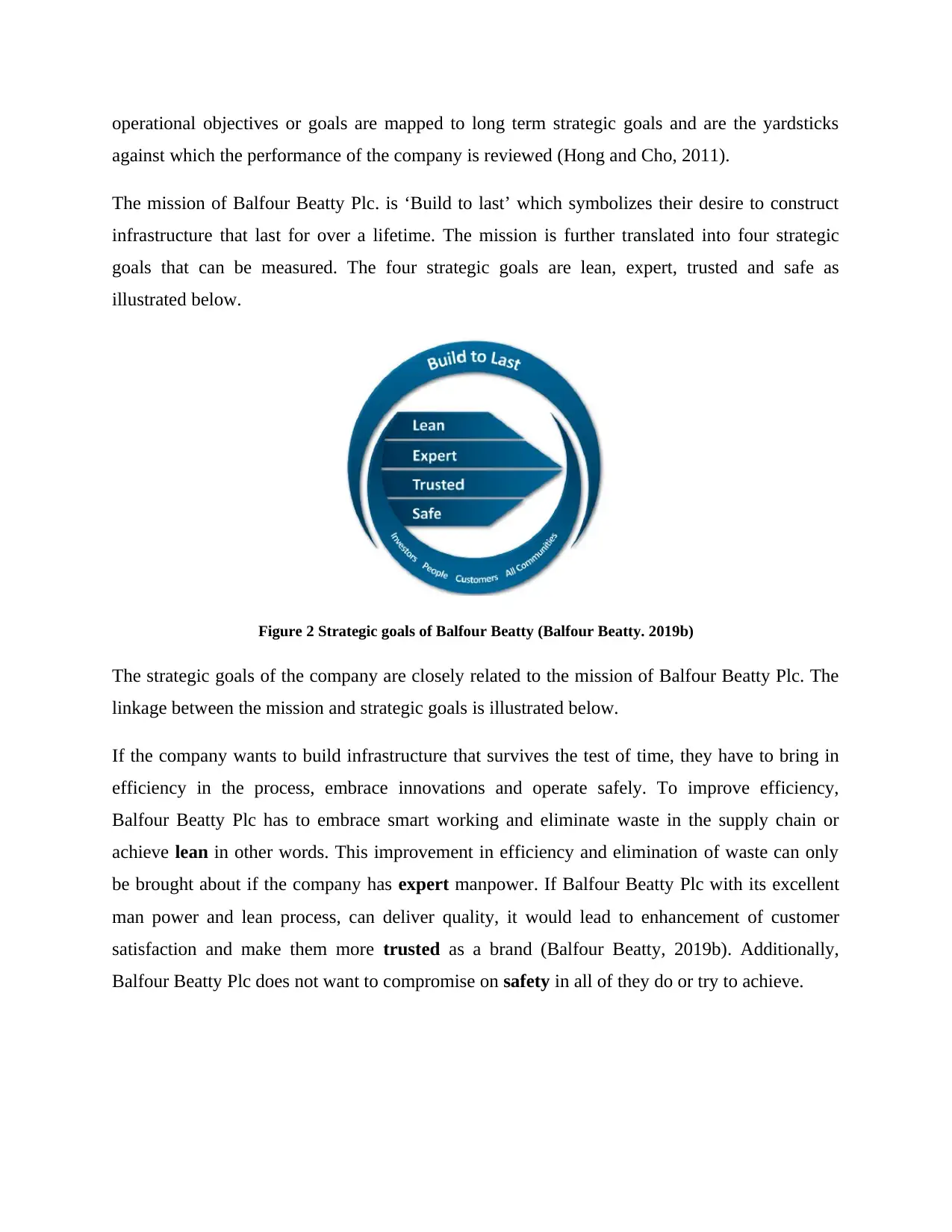
operational objectives or goals are mapped to long term strategic goals and are the yardsticks
against which the performance of the company is reviewed (Hong and Cho, 2011).
The mission of Balfour Beatty Plc. is ‘Build to last’ which symbolizes their desire to construct
infrastructure that last for over a lifetime. The mission is further translated into four strategic
goals that can be measured. The four strategic goals are lean, expert, trusted and safe as
illustrated below.
Figure 2 Strategic goals of Balfour Beatty (Balfour Beatty. 2019b)
The strategic goals of the company are closely related to the mission of Balfour Beatty Plc. The
linkage between the mission and strategic goals is illustrated below.
If the company wants to build infrastructure that survives the test of time, they have to bring in
efficiency in the process, embrace innovations and operate safely. To improve efficiency,
Balfour Beatty Plc has to embrace smart working and eliminate waste in the supply chain or
achieve lean in other words. This improvement in efficiency and elimination of waste can only
be brought about if the company has expert manpower. If Balfour Beatty Plc with its excellent
man power and lean process, can deliver quality, it would lead to enhancement of customer
satisfaction and make them more trusted as a brand (Balfour Beatty, 2019b). Additionally,
Balfour Beatty Plc does not want to compromise on safety in all of they do or try to achieve.
against which the performance of the company is reviewed (Hong and Cho, 2011).
The mission of Balfour Beatty Plc. is ‘Build to last’ which symbolizes their desire to construct
infrastructure that last for over a lifetime. The mission is further translated into four strategic
goals that can be measured. The four strategic goals are lean, expert, trusted and safe as
illustrated below.
Figure 2 Strategic goals of Balfour Beatty (Balfour Beatty. 2019b)
The strategic goals of the company are closely related to the mission of Balfour Beatty Plc. The
linkage between the mission and strategic goals is illustrated below.
If the company wants to build infrastructure that survives the test of time, they have to bring in
efficiency in the process, embrace innovations and operate safely. To improve efficiency,
Balfour Beatty Plc has to embrace smart working and eliminate waste in the supply chain or
achieve lean in other words. This improvement in efficiency and elimination of waste can only
be brought about if the company has expert manpower. If Balfour Beatty Plc with its excellent
man power and lean process, can deliver quality, it would lead to enhancement of customer
satisfaction and make them more trusted as a brand (Balfour Beatty, 2019b). Additionally,
Balfour Beatty Plc does not want to compromise on safety in all of they do or try to achieve.
Paraphrase This Document
Need a fresh take? Get an instant paraphrase of this document with our AI Paraphraser
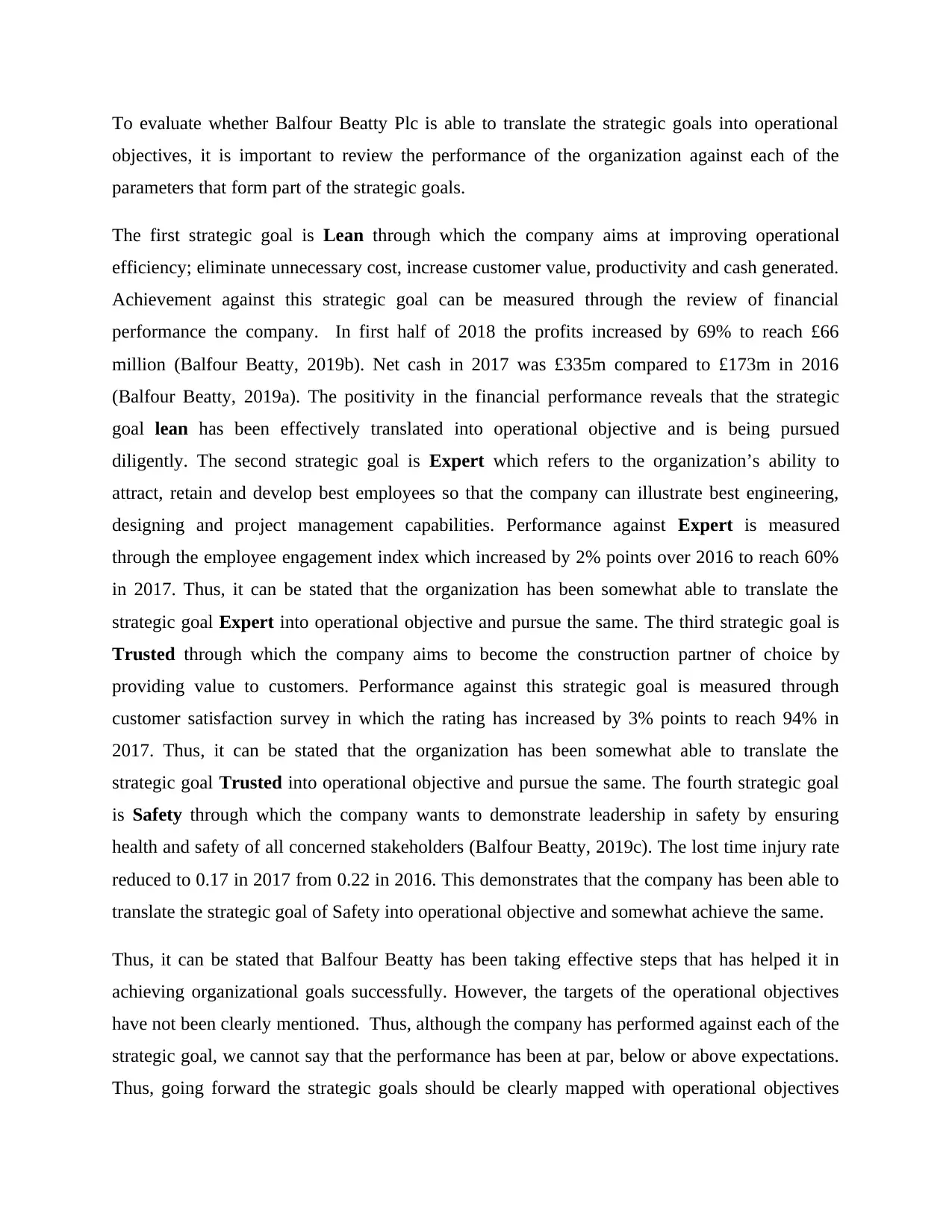
To evaluate whether Balfour Beatty Plc is able to translate the strategic goals into operational
objectives, it is important to review the performance of the organization against each of the
parameters that form part of the strategic goals.
The first strategic goal is Lean through which the company aims at improving operational
efficiency; eliminate unnecessary cost, increase customer value, productivity and cash generated.
Achievement against this strategic goal can be measured through the review of financial
performance the company. In first half of 2018 the profits increased by 69% to reach £66
million (Balfour Beatty, 2019b). Net cash in 2017 was £335m compared to £173m in 2016
(Balfour Beatty, 2019a). The positivity in the financial performance reveals that the strategic
goal lean has been effectively translated into operational objective and is being pursued
diligently. The second strategic goal is Expert which refers to the organization’s ability to
attract, retain and develop best employees so that the company can illustrate best engineering,
designing and project management capabilities. Performance against Expert is measured
through the employee engagement index which increased by 2% points over 2016 to reach 60%
in 2017. Thus, it can be stated that the organization has been somewhat able to translate the
strategic goal Expert into operational objective and pursue the same. The third strategic goal is
Trusted through which the company aims to become the construction partner of choice by
providing value to customers. Performance against this strategic goal is measured through
customer satisfaction survey in which the rating has increased by 3% points to reach 94% in
2017. Thus, it can be stated that the organization has been somewhat able to translate the
strategic goal Trusted into operational objective and pursue the same. The fourth strategic goal
is Safety through which the company wants to demonstrate leadership in safety by ensuring
health and safety of all concerned stakeholders (Balfour Beatty, 2019c). The lost time injury rate
reduced to 0.17 in 2017 from 0.22 in 2016. This demonstrates that the company has been able to
translate the strategic goal of Safety into operational objective and somewhat achieve the same.
Thus, it can be stated that Balfour Beatty has been taking effective steps that has helped it in
achieving organizational goals successfully. However, the targets of the operational objectives
have not been clearly mentioned. Thus, although the company has performed against each of the
strategic goal, we cannot say that the performance has been at par, below or above expectations.
Thus, going forward the strategic goals should be clearly mapped with operational objectives
objectives, it is important to review the performance of the organization against each of the
parameters that form part of the strategic goals.
The first strategic goal is Lean through which the company aims at improving operational
efficiency; eliminate unnecessary cost, increase customer value, productivity and cash generated.
Achievement against this strategic goal can be measured through the review of financial
performance the company. In first half of 2018 the profits increased by 69% to reach £66
million (Balfour Beatty, 2019b). Net cash in 2017 was £335m compared to £173m in 2016
(Balfour Beatty, 2019a). The positivity in the financial performance reveals that the strategic
goal lean has been effectively translated into operational objective and is being pursued
diligently. The second strategic goal is Expert which refers to the organization’s ability to
attract, retain and develop best employees so that the company can illustrate best engineering,
designing and project management capabilities. Performance against Expert is measured
through the employee engagement index which increased by 2% points over 2016 to reach 60%
in 2017. Thus, it can be stated that the organization has been somewhat able to translate the
strategic goal Expert into operational objective and pursue the same. The third strategic goal is
Trusted through which the company aims to become the construction partner of choice by
providing value to customers. Performance against this strategic goal is measured through
customer satisfaction survey in which the rating has increased by 3% points to reach 94% in
2017. Thus, it can be stated that the organization has been somewhat able to translate the
strategic goal Trusted into operational objective and pursue the same. The fourth strategic goal
is Safety through which the company wants to demonstrate leadership in safety by ensuring
health and safety of all concerned stakeholders (Balfour Beatty, 2019c). The lost time injury rate
reduced to 0.17 in 2017 from 0.22 in 2016. This demonstrates that the company has been able to
translate the strategic goal of Safety into operational objective and somewhat achieve the same.
Thus, it can be stated that Balfour Beatty has been taking effective steps that has helped it in
achieving organizational goals successfully. However, the targets of the operational objectives
have not been clearly mentioned. Thus, although the company has performed against each of the
strategic goal, we cannot say that the performance has been at par, below or above expectations.
Thus, going forward the strategic goals should be clearly mapped with operational objectives

with a clear target and specific time frame. For instance the operational goal with respect to
Expert can be to ensure that employee engagement is at 63% in the year 2019.
Expert can be to ensure that employee engagement is at 63% in the year 2019.
⊘ This is a preview!⊘
Do you want full access?
Subscribe today to unlock all pages.

Trusted by 1+ million students worldwide
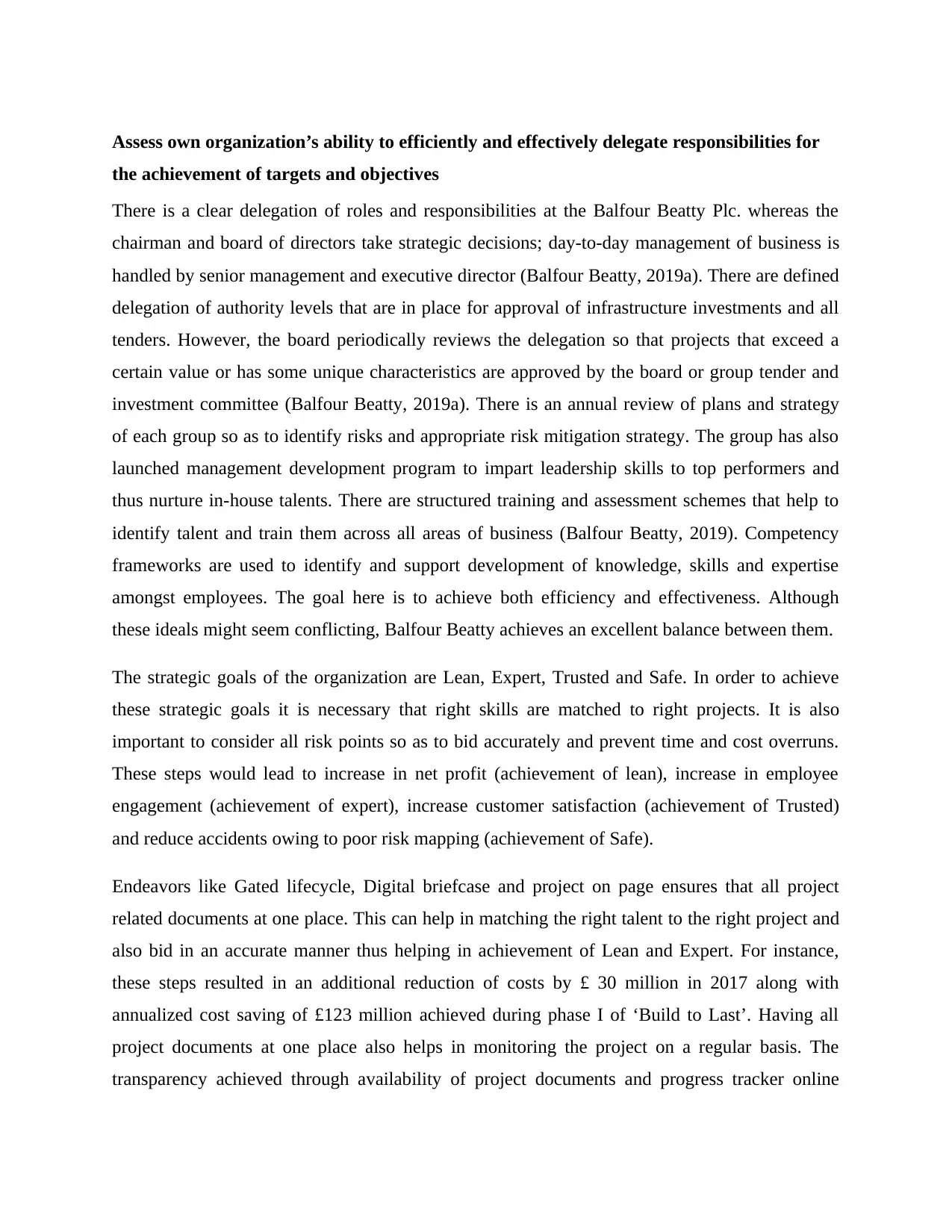
Assess own organization’s ability to efficiently and effectively delegate responsibilities for
the achievement of targets and objectives
There is a clear delegation of roles and responsibilities at the Balfour Beatty Plc. whereas the
chairman and board of directors take strategic decisions; day-to-day management of business is
handled by senior management and executive director (Balfour Beatty, 2019a). There are defined
delegation of authority levels that are in place for approval of infrastructure investments and all
tenders. However, the board periodically reviews the delegation so that projects that exceed a
certain value or has some unique characteristics are approved by the board or group tender and
investment committee (Balfour Beatty, 2019a). There is an annual review of plans and strategy
of each group so as to identify risks and appropriate risk mitigation strategy. The group has also
launched management development program to impart leadership skills to top performers and
thus nurture in-house talents. There are structured training and assessment schemes that help to
identify talent and train them across all areas of business (Balfour Beatty, 2019). Competency
frameworks are used to identify and support development of knowledge, skills and expertise
amongst employees. The goal here is to achieve both efficiency and effectiveness. Although
these ideals might seem conflicting, Balfour Beatty achieves an excellent balance between them.
The strategic goals of the organization are Lean, Expert, Trusted and Safe. In order to achieve
these strategic goals it is necessary that right skills are matched to right projects. It is also
important to consider all risk points so as to bid accurately and prevent time and cost overruns.
These steps would lead to increase in net profit (achievement of lean), increase in employee
engagement (achievement of expert), increase customer satisfaction (achievement of Trusted)
and reduce accidents owing to poor risk mapping (achievement of Safe).
Endeavors like Gated lifecycle, Digital briefcase and project on page ensures that all project
related documents at one place. This can help in matching the right talent to the right project and
also bid in an accurate manner thus helping in achievement of Lean and Expert. For instance,
these steps resulted in an additional reduction of costs by £ 30 million in 2017 along with
annualized cost saving of £123 million achieved during phase I of ‘Build to Last’. Having all
project documents at one place also helps in monitoring the project on a regular basis. The
transparency achieved through availability of project documents and progress tracker online
the achievement of targets and objectives
There is a clear delegation of roles and responsibilities at the Balfour Beatty Plc. whereas the
chairman and board of directors take strategic decisions; day-to-day management of business is
handled by senior management and executive director (Balfour Beatty, 2019a). There are defined
delegation of authority levels that are in place for approval of infrastructure investments and all
tenders. However, the board periodically reviews the delegation so that projects that exceed a
certain value or has some unique characteristics are approved by the board or group tender and
investment committee (Balfour Beatty, 2019a). There is an annual review of plans and strategy
of each group so as to identify risks and appropriate risk mitigation strategy. The group has also
launched management development program to impart leadership skills to top performers and
thus nurture in-house talents. There are structured training and assessment schemes that help to
identify talent and train them across all areas of business (Balfour Beatty, 2019). Competency
frameworks are used to identify and support development of knowledge, skills and expertise
amongst employees. The goal here is to achieve both efficiency and effectiveness. Although
these ideals might seem conflicting, Balfour Beatty achieves an excellent balance between them.
The strategic goals of the organization are Lean, Expert, Trusted and Safe. In order to achieve
these strategic goals it is necessary that right skills are matched to right projects. It is also
important to consider all risk points so as to bid accurately and prevent time and cost overruns.
These steps would lead to increase in net profit (achievement of lean), increase in employee
engagement (achievement of expert), increase customer satisfaction (achievement of Trusted)
and reduce accidents owing to poor risk mapping (achievement of Safe).
Endeavors like Gated lifecycle, Digital briefcase and project on page ensures that all project
related documents at one place. This can help in matching the right talent to the right project and
also bid in an accurate manner thus helping in achievement of Lean and Expert. For instance,
these steps resulted in an additional reduction of costs by £ 30 million in 2017 along with
annualized cost saving of £123 million achieved during phase I of ‘Build to Last’. Having all
project documents at one place also helps in monitoring the project on a regular basis. The
transparency achieved through availability of project documents and progress tracker online
Paraphrase This Document
Need a fresh take? Get an instant paraphrase of this document with our AI Paraphraser
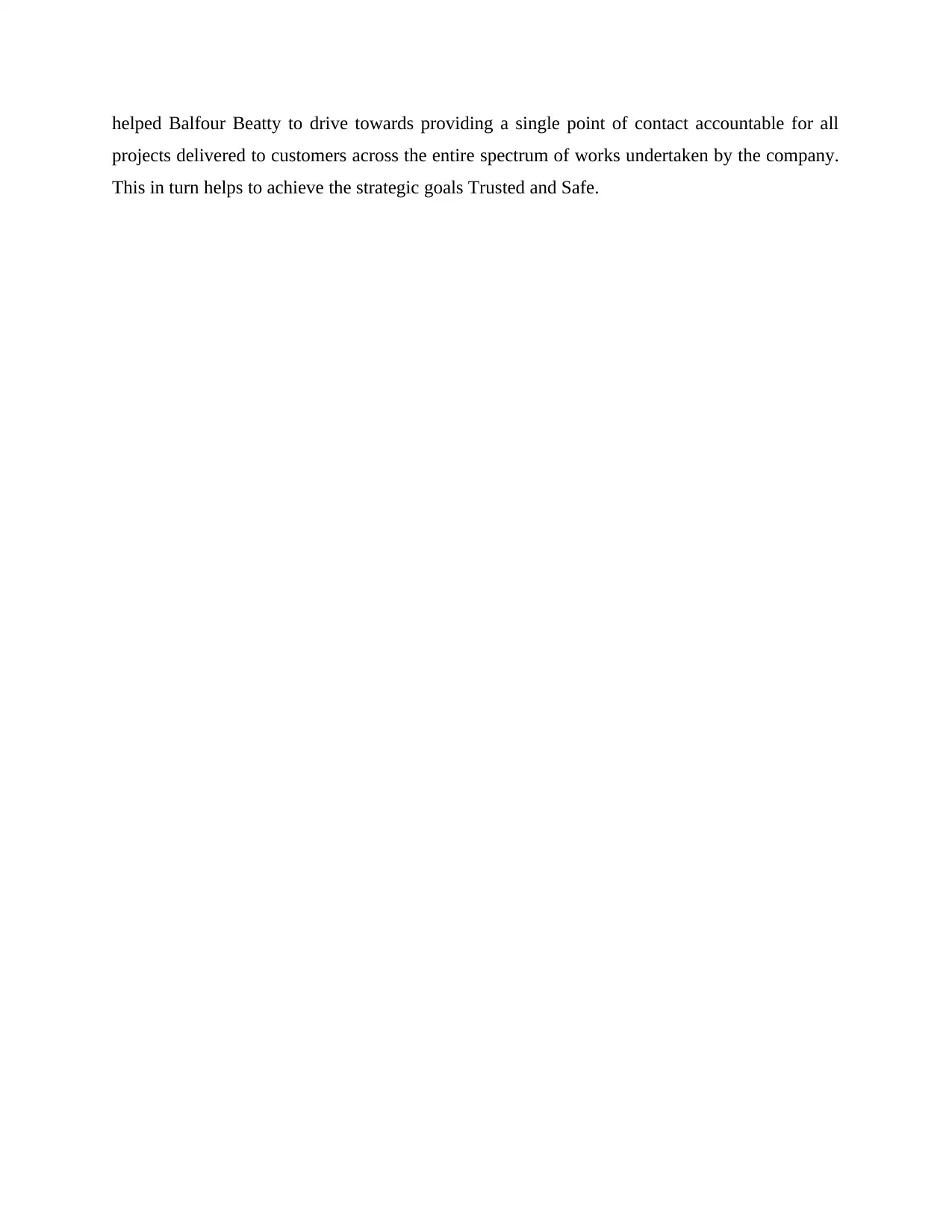
helped Balfour Beatty to drive towards providing a single point of contact accountable for all
projects delivered to customers across the entire spectrum of works undertaken by the company.
This in turn helps to achieve the strategic goals Trusted and Safe.
projects delivered to customers across the entire spectrum of works undertaken by the company.
This in turn helps to achieve the strategic goals Trusted and Safe.
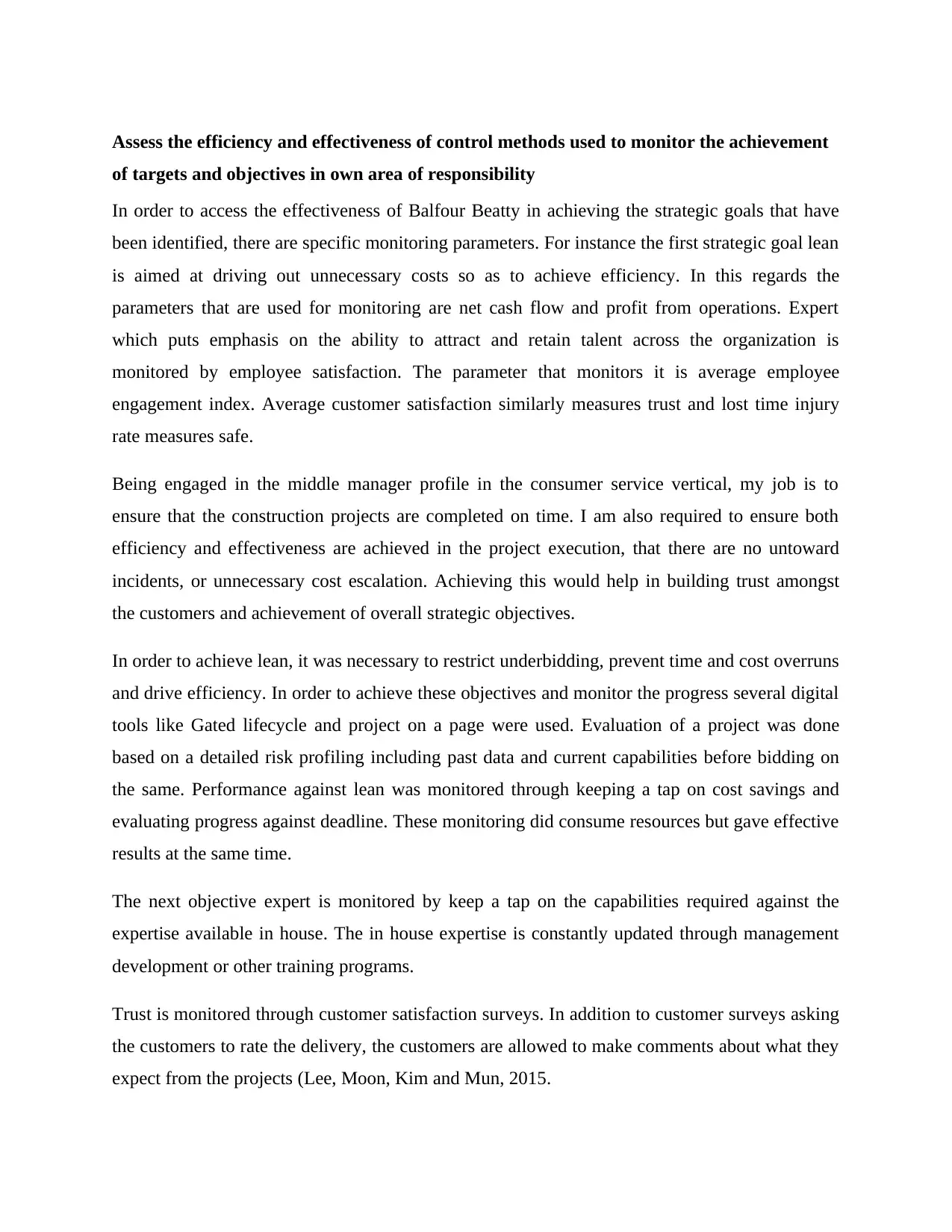
Assess the efficiency and effectiveness of control methods used to monitor the achievement
of targets and objectives in own area of responsibility
In order to access the effectiveness of Balfour Beatty in achieving the strategic goals that have
been identified, there are specific monitoring parameters. For instance the first strategic goal lean
is aimed at driving out unnecessary costs so as to achieve efficiency. In this regards the
parameters that are used for monitoring are net cash flow and profit from operations. Expert
which puts emphasis on the ability to attract and retain talent across the organization is
monitored by employee satisfaction. The parameter that monitors it is average employee
engagement index. Average customer satisfaction similarly measures trust and lost time injury
rate measures safe.
Being engaged in the middle manager profile in the consumer service vertical, my job is to
ensure that the construction projects are completed on time. I am also required to ensure both
efficiency and effectiveness are achieved in the project execution, that there are no untoward
incidents, or unnecessary cost escalation. Achieving this would help in building trust amongst
the customers and achievement of overall strategic objectives.
In order to achieve lean, it was necessary to restrict underbidding, prevent time and cost overruns
and drive efficiency. In order to achieve these objectives and monitor the progress several digital
tools like Gated lifecycle and project on a page were used. Evaluation of a project was done
based on a detailed risk profiling including past data and current capabilities before bidding on
the same. Performance against lean was monitored through keeping a tap on cost savings and
evaluating progress against deadline. These monitoring did consume resources but gave effective
results at the same time.
The next objective expert is monitored by keep a tap on the capabilities required against the
expertise available in house. The in house expertise is constantly updated through management
development or other training programs.
Trust is monitored through customer satisfaction surveys. In addition to customer surveys asking
the customers to rate the delivery, the customers are allowed to make comments about what they
expect from the projects (Lee, Moon, Kim and Mun, 2015.
of targets and objectives in own area of responsibility
In order to access the effectiveness of Balfour Beatty in achieving the strategic goals that have
been identified, there are specific monitoring parameters. For instance the first strategic goal lean
is aimed at driving out unnecessary costs so as to achieve efficiency. In this regards the
parameters that are used for monitoring are net cash flow and profit from operations. Expert
which puts emphasis on the ability to attract and retain talent across the organization is
monitored by employee satisfaction. The parameter that monitors it is average employee
engagement index. Average customer satisfaction similarly measures trust and lost time injury
rate measures safe.
Being engaged in the middle manager profile in the consumer service vertical, my job is to
ensure that the construction projects are completed on time. I am also required to ensure both
efficiency and effectiveness are achieved in the project execution, that there are no untoward
incidents, or unnecessary cost escalation. Achieving this would help in building trust amongst
the customers and achievement of overall strategic objectives.
In order to achieve lean, it was necessary to restrict underbidding, prevent time and cost overruns
and drive efficiency. In order to achieve these objectives and monitor the progress several digital
tools like Gated lifecycle and project on a page were used. Evaluation of a project was done
based on a detailed risk profiling including past data and current capabilities before bidding on
the same. Performance against lean was monitored through keeping a tap on cost savings and
evaluating progress against deadline. These monitoring did consume resources but gave effective
results at the same time.
The next objective expert is monitored by keep a tap on the capabilities required against the
expertise available in house. The in house expertise is constantly updated through management
development or other training programs.
Trust is monitored through customer satisfaction surveys. In addition to customer surveys asking
the customers to rate the delivery, the customers are allowed to make comments about what they
expect from the projects (Lee, Moon, Kim and Mun, 2015.
⊘ This is a preview!⊘
Do you want full access?
Subscribe today to unlock all pages.

Trusted by 1+ million students worldwide
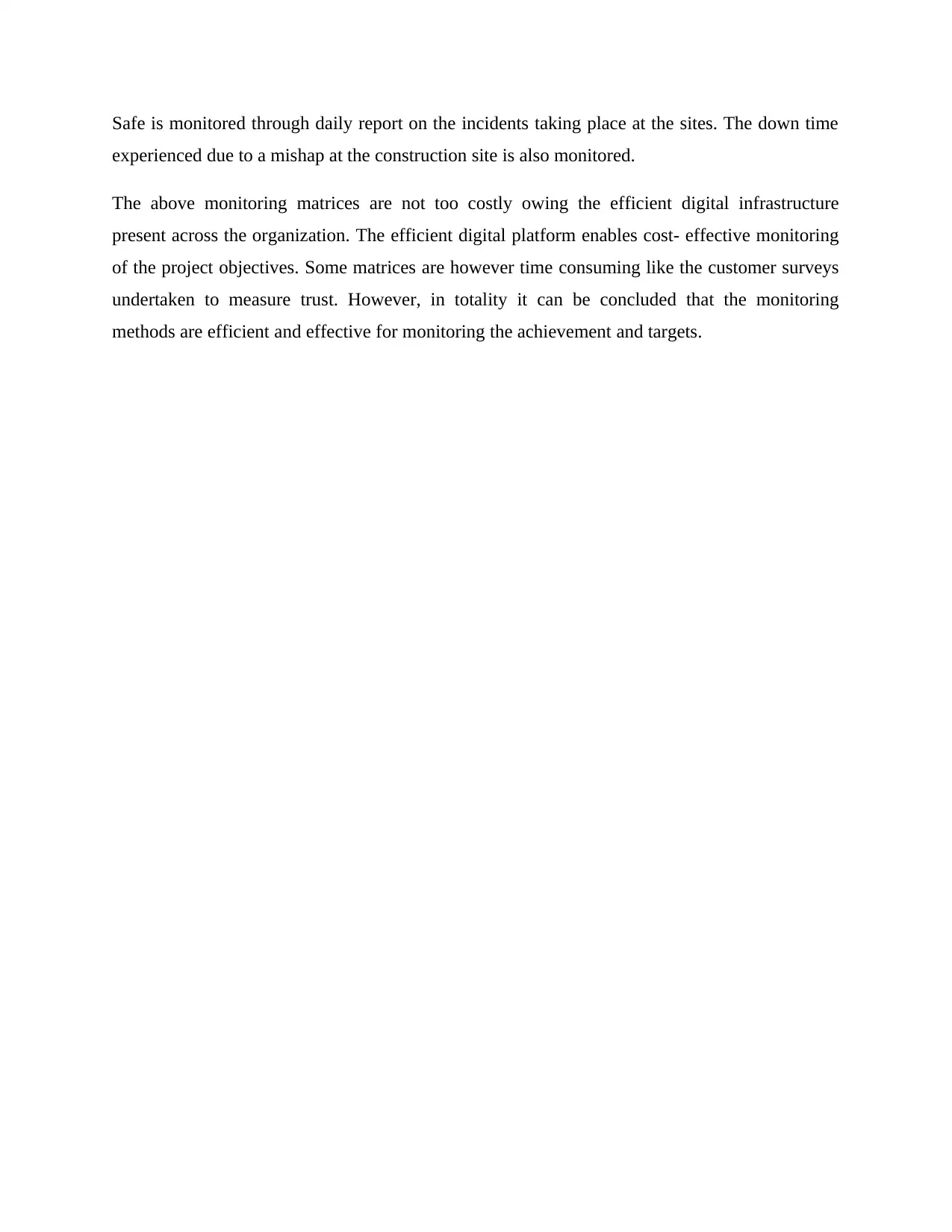
Safe is monitored through daily report on the incidents taking place at the sites. The down time
experienced due to a mishap at the construction site is also monitored.
The above monitoring matrices are not too costly owing the efficient digital infrastructure
present across the organization. The efficient digital platform enables cost- effective monitoring
of the project objectives. Some matrices are however time consuming like the customer surveys
undertaken to measure trust. However, in totality it can be concluded that the monitoring
methods are efficient and effective for monitoring the achievement and targets.
experienced due to a mishap at the construction site is also monitored.
The above monitoring matrices are not too costly owing the efficient digital infrastructure
present across the organization. The efficient digital platform enables cost- effective monitoring
of the project objectives. Some matrices are however time consuming like the customer surveys
undertaken to measure trust. However, in totality it can be concluded that the monitoring
methods are efficient and effective for monitoring the achievement and targets.
Paraphrase This Document
Need a fresh take? Get an instant paraphrase of this document with our AI Paraphraser
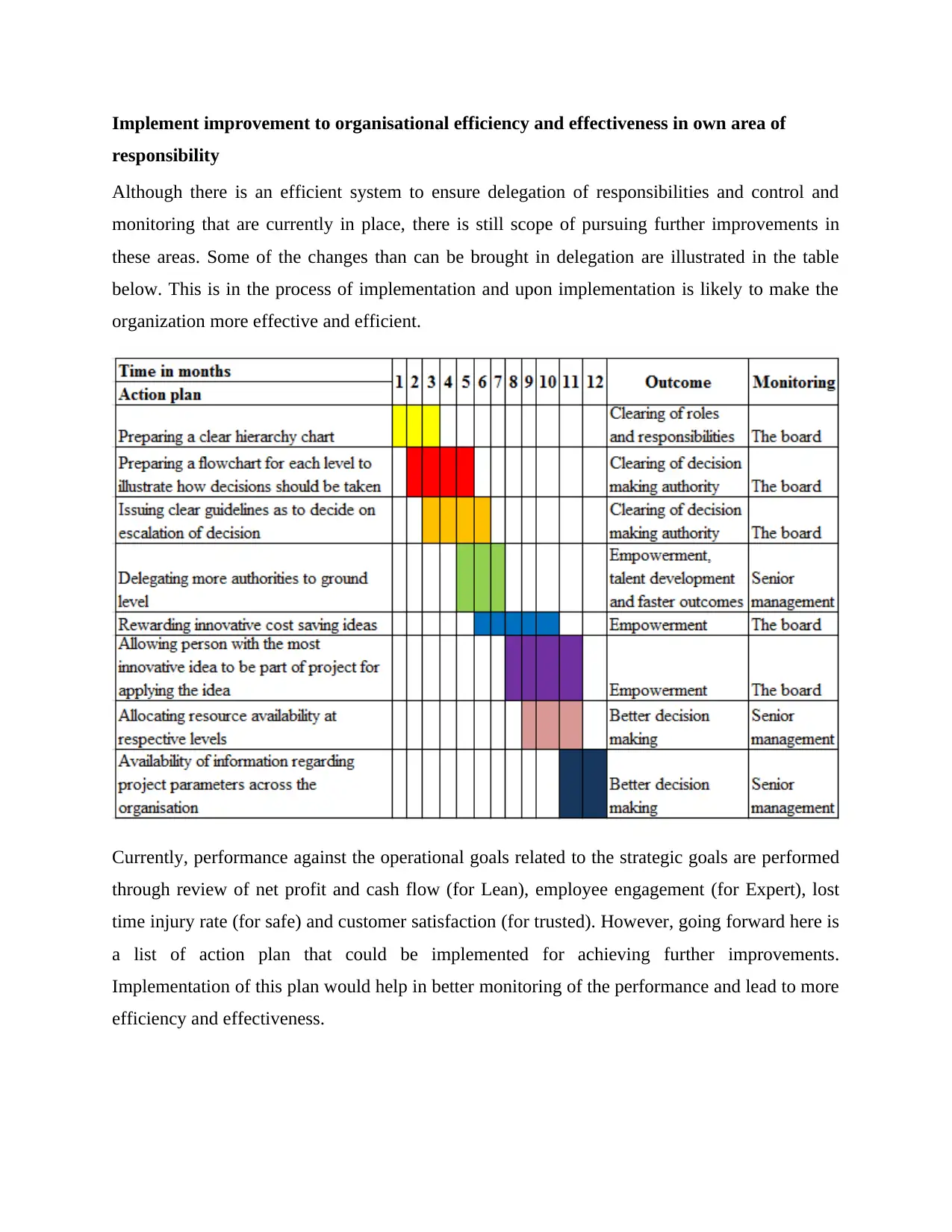
Implement improvement to organisational efficiency and effectiveness in own area of
responsibility
Although there is an efficient system to ensure delegation of responsibilities and control and
monitoring that are currently in place, there is still scope of pursuing further improvements in
these areas. Some of the changes than can be brought in delegation are illustrated in the table
below. This is in the process of implementation and upon implementation is likely to make the
organization more effective and efficient.
Currently, performance against the operational goals related to the strategic goals are performed
through review of net profit and cash flow (for Lean), employee engagement (for Expert), lost
time injury rate (for safe) and customer satisfaction (for trusted). However, going forward here is
a list of action plan that could be implemented for achieving further improvements.
Implementation of this plan would help in better monitoring of the performance and lead to more
efficiency and effectiveness.
responsibility
Although there is an efficient system to ensure delegation of responsibilities and control and
monitoring that are currently in place, there is still scope of pursuing further improvements in
these areas. Some of the changes than can be brought in delegation are illustrated in the table
below. This is in the process of implementation and upon implementation is likely to make the
organization more effective and efficient.
Currently, performance against the operational goals related to the strategic goals are performed
through review of net profit and cash flow (for Lean), employee engagement (for Expert), lost
time injury rate (for safe) and customer satisfaction (for trusted). However, going forward here is
a list of action plan that could be implemented for achieving further improvements.
Implementation of this plan would help in better monitoring of the performance and lead to more
efficiency and effectiveness.
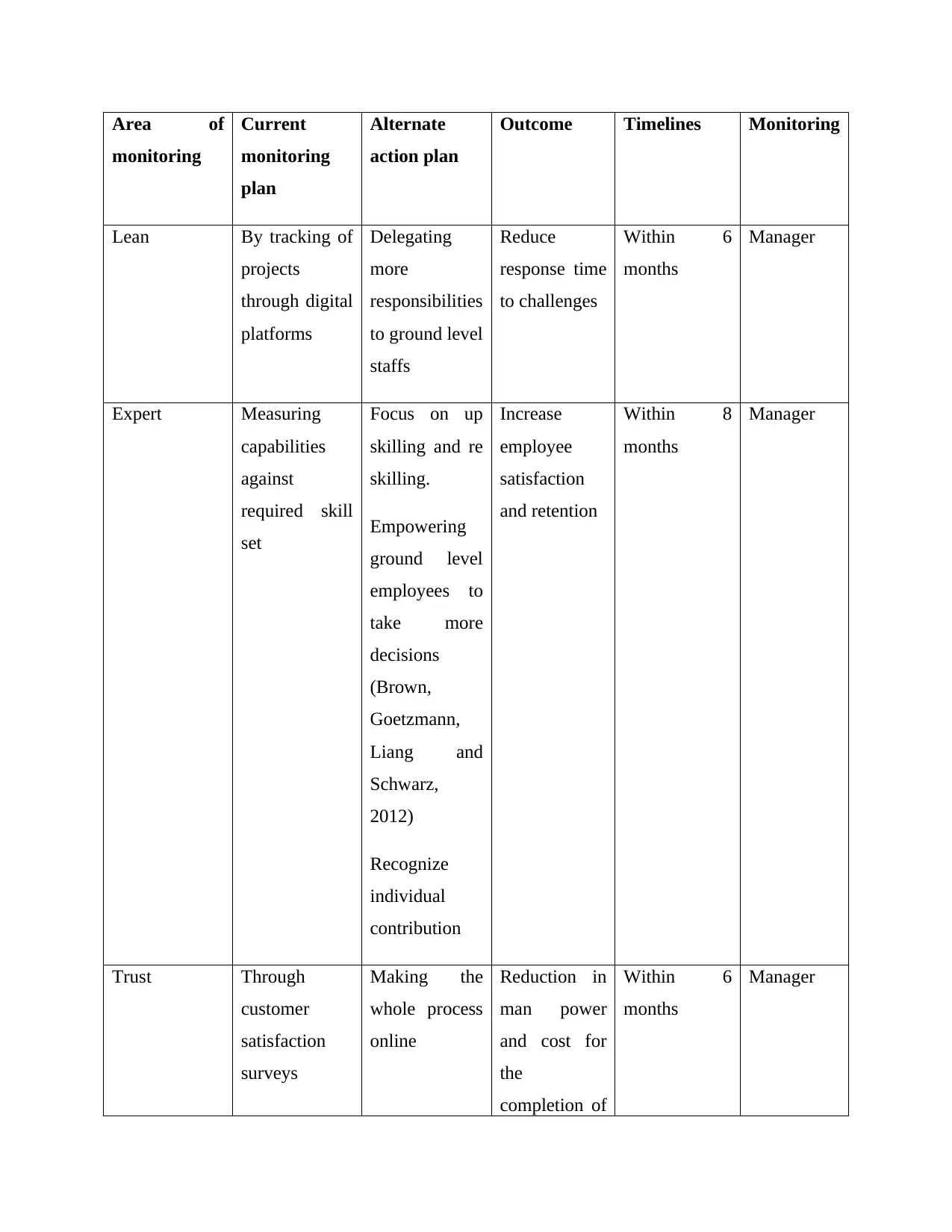
Area of
monitoring
Current
monitoring
plan
Alternate
action plan
Outcome Timelines Monitoring
Lean By tracking of
projects
through digital
platforms
Delegating
more
responsibilities
to ground level
staffs
Reduce
response time
to challenges
Within 6
months
Manager
Expert Measuring
capabilities
against
required skill
set
Focus on up
skilling and re
skilling.
Empowering
ground level
employees to
take more
decisions
(Brown,
Goetzmann,
Liang and
Schwarz,
2012)
Recognize
individual
contribution
Increase
employee
satisfaction
and retention
Within 8
months
Manager
Trust Through
customer
satisfaction
surveys
Making the
whole process
online
Reduction in
man power
and cost for
the
completion of
Within 6
months
Manager
monitoring
Current
monitoring
plan
Alternate
action plan
Outcome Timelines Monitoring
Lean By tracking of
projects
through digital
platforms
Delegating
more
responsibilities
to ground level
staffs
Reduce
response time
to challenges
Within 6
months
Manager
Expert Measuring
capabilities
against
required skill
set
Focus on up
skilling and re
skilling.
Empowering
ground level
employees to
take more
decisions
(Brown,
Goetzmann,
Liang and
Schwarz,
2012)
Recognize
individual
contribution
Increase
employee
satisfaction
and retention
Within 8
months
Manager
Trust Through
customer
satisfaction
surveys
Making the
whole process
online
Reduction in
man power
and cost for
the
completion of
Within 6
months
Manager
⊘ This is a preview!⊘
Do you want full access?
Subscribe today to unlock all pages.

Trusted by 1+ million students worldwide
1 out of 18
Related Documents
Your All-in-One AI-Powered Toolkit for Academic Success.
+13062052269
info@desklib.com
Available 24*7 on WhatsApp / Email
![[object Object]](/_next/static/media/star-bottom.7253800d.svg)
Unlock your academic potential
Copyright © 2020–2025 A2Z Services. All Rights Reserved. Developed and managed by ZUCOL.





